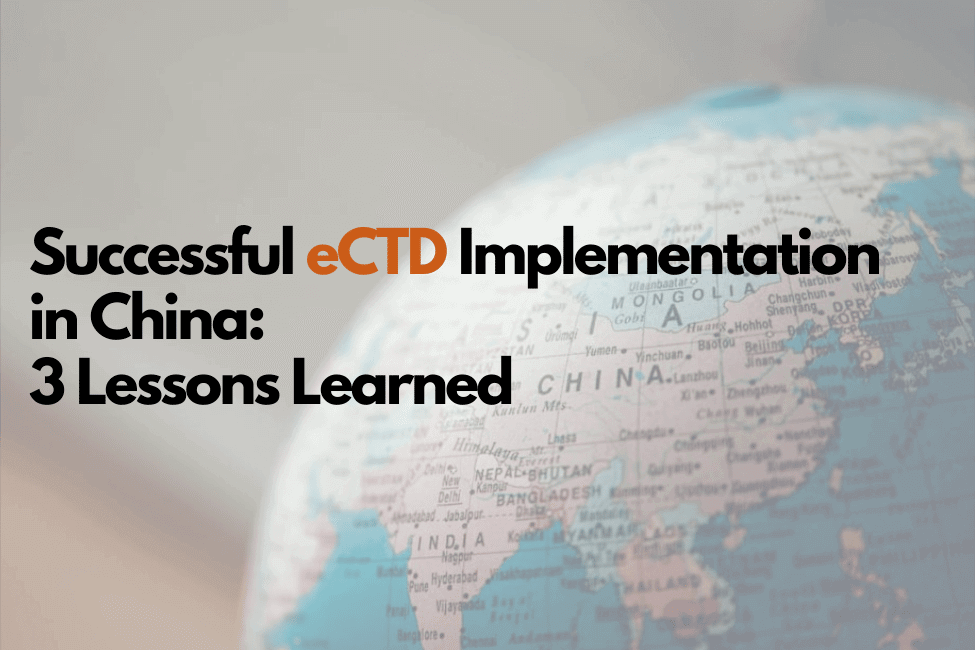China is the most populous country on the planet accounting for more than 18% of the world’s population. Following the focus placed on biopharmaceutical development by the Chinese government in the last decade, the country’s global industry ranking rose from 9th largest in 2007 to 2nd in 2017.
To help expedite the review and approval of new medicines, China will soon join other Asia Pacific countries in accepting submissions in a fully electronic eCTD format. The implementation of eCTD in Japan and Thailand highlighted many hurdles for both domestic and international biopharmaceutical companies, some of which can be avoided.
CFDA eCTD Adoption
After joining the ICH (International Conference on Harmonization) in June 2017, China’s draft eCTD guidance has now been provided by the CFDA (China Food & Drug Administration). It is time for any organisation looking to gain approval for their products in the Chinese market to prepare to take advantage of this regulatory change.
- eCTD approach.
- The CFDA is adopting the ICH specification 3.2.2. This means it will more closely follow the US FDA’s submission process rather than the European EMA’s implementation (or the Japanese PMDA with its unique approach to lifecycle).
- Clinical trial datasets and Study Tagging Files (STF) will be required and node extensions will not for example.
- Chinese language usage.
- Documents will be required in Chinese with English versions as reference.
- eCTD leaf titles will also be required in Chinese.
- Review and validation.
- Submissions are expected via CD/DVD delivery initially with an electronic gateway in the future.
- A link is expected from the CDE (Centre for Drug Evaluation) website which will allow for free submission validation (they will be using LORENZ (member of the Alliance of Experts) technology for their own validation, review and management).
Top 3 considerations when implementing eCTD in China.
- Thoroughly review all supporting technology required.
- Review whether a new publishing solution is required to deal with the specific Chinese eCTD needs. A solution that was ideal for EU and US submissions may no longer be the preferred platform once Chinese conditions are added. As an example, companies often used different tools for Japanese submissions, because of their unique requirements. Consolidating on common tools, however, provides huge efficiencies and savings across global regulatory teams.
- Ensure a rendering platform that can convert all required original source content into fully technically ICH-compliant PDF files is in place, and that multi-byte Chinese character sets are well handled. Many companies un-necessarily continue to struggle to implement a single consistent platform that handles the needs of both Asian and Western character sets. Most often, local tools are used to ensure the converted content meets the local technical submission guidelines.
- Ensure all supporting content creation, management, manipulation, publishing and validation technologies support the multi-byte Chinese documents which will be used.
- Thoroughly test all solutions in as close to real world conditions as possible (use pilots where possible).
- Understand the cultural requirements as well as the technical requirements.
- Flexibility is required to account for different interpretations of ‘recommendations’ in any guidelines. While Japanese companies, for example, typically strictly adhere to all rules including any recommendations, companies in the US might choose not to follow some recommendations where particular efficiencies might be gained by not doing so. A similar understanding of the Chinese approach in these situations is essential to a successful implementation of eCTD.
- Having a partner based in China or with a very deep understanding of the Chinese regulatory culture is critical to success. As with any region, historical and cultural knowledge when dealing with the local authority can be critical in ensuring a timely submission process.
- Ensure teams affected are thoroughly trained.
- eCTD provides significant benefits, but the tools and processes require a great deal more training than most companies allow for.
- Start training early. Training should begin well before the first submission in eCTD to China is planned.
- Get involved with any pilots should there be any. This provides the best way to test your systems and internal processes prior to a live submission. Ensure you test lifecycle updates as well as the initial 0000 submission. You will receive invaluable feedback no matter how well organised you are.
Conclusion
With such a huge quantity of applications being received, the implementation of eCTD will certainly help provide a timelier review process and continue to help alleviate the backlog of work for the CDE.
| REVIEW RESULTS . | ||||
| APPLICATION TYPE | APPROVED | REFUSED | OTHER | TOTAL |
| IND | 554 | 12 | 37 | 603 |
| Confirmatory clinical trial | 130 | 14 | 96 | 240 |
| NDA | 132 | 9 | 65 | 206 |
| ANDA | 1038 | 115 | 1200 | 2353 |
| Supplementary application | 1776 | 127 | 511 | 2414 |
| Import re-registration | 395 | 27 | 60 | 482 |
| Generic drug QCE | / | 238 | ||
| Re-review | / | 88 | ||
| TOTALS | 4,025 | 304 | 1,969 | 6,624 |
| Chemical drugs reviewed by CDE in 2018 | ||||
Since the initial release will not mandate the use of eCTD, this transition period provides biopharmaceutical companies with the opportunity to avoid some of the headaches they faced when adjusting their processes for other regions. Supporting technologies have also evolved since eCTD was first introduced to the global stage and harnessing some of these can further ease this evolution in China.
DocShifter supports the transformation of content into formats required by the CFDA and other regulatory health authorities.
You can download the PDF version of this article as well. Please click here to download the “eCTD in China” article in a PDF format.
Did you enjoy this blog post? We have more free knowledge-articles available for you.
Thank you very much for reading our blog post, we hope you enjoyed it.
For more free articles on regulatory topics (eCTD, regulatory submissions, RIM, eCTD v4.0, etc.) we invite you to join our free LinkedIn Regulatory Community.
This community is where we share tips & tricks, updates and learnings on regulatory topics. The community currently has 2500 members and is growing quickly.
The PDF format specifications checklist for FDA submissions.
- eCTD 4.0: Key Changes & Impact on Submission Content Preparation
If you think this is interesting, I would like to personally invite you to join the Regulatory Professionals Community. And don’t worry, it is completely free.
About DocShifter
Speed, quality, scalability, and configurability are reasons why Life Sciences organizations choose DocShifter to generate technically compliant, submission-ready PDF. High volume, high-quality document conversion, on-premises, or in the cloud. Super easy to set up. Automate. Centralize. Eliminate manual intervention. Reduce Risk. Reduce IT infrastructure costs.
Bonus: We created an FDA PDF format specifications checklist for you, so that you can identify content-related issues as soon as possible to reduce the risk of RTF.
You can download the checklist here.




